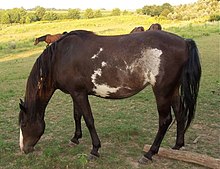 Spanish Mustang mare | |
| Country of origin | Developed in the Americas from foundation bloodstock tracing to Spain |
|---|---|
| Traits | |
| Distinguishing features | Compact, sturdy, Spanish type |
The Spanish Mustang is an American horse breed descended from horses brought from Spain during the early conquest of the Americas. They are classified within the larger grouping of the Colonial Spanish horse, a type that today is rare in Spain.[1] By the early 20th century, most of the once-vast herds of mustangs that had descended from the Spanish horses had been greatly reduced in size. Seeing that these horses were on the brink of extinction, some horseman began making efforts to find and preserve the remaining "Spanish Mustangs" drawing stock from feral and Native American herds, as well as ranch stock. The breed was one of the first to be part of a concerted preservation effort for horses of Spanish phenotype, and a breed registry was founded in 1957.
The Spanish Mustang as a modern domesticated breed differs from the feral free-roaming mustang.[2] The latter animals are descended from both Spanish horses and other domesticated horses escaped or released from various sources; many run wild in Herd Management Areas (HMAs) of the western United States, currently managed by the Bureau of Land Management (BLM). Some feral herds also exist in Canada. DNA studies indicate that Spanish breeding and type does still exist in some feral Mustang herds, including those on the Cerbat HMA (near Kingman, Arizona),[3] Pryor Mountain HMA (Montana),[4] Sulphur HMA (Utah),[5] and Kiger HMA (Oregon).[6]
- ^ Sponenberg, D. Phillip. "North American Colonial Spanish Horse Part I, History and Type". Conquistador Magazine. Retrieved June 5, 2006.
- ^ "History of the Spanish Mustang". Spanish Mustang Registry. Archived from the original on August 16, 2022. Retrieved August 25, 2015.
- ^ "Cerbat Herd Area". Bureau of Land Management. Archived from the original on 1 June 2015. Retrieved 30 May 2015.
- ^ "Pryor Mountain Wild Horse Range". Bureau of Land Management. Archived from the original on 16 June 2015. Retrieved 1 June 2015.
- ^ "GusCothran". americanspanishsulphur.org. Retrieved 28 August 2015.
- ^ Sponenberg, D. Philip. "North American Colonial Spanish Horse Update July 2011". Retrieved August 16, 2015.